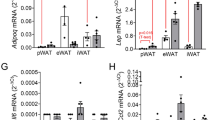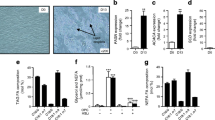Abstract
The objective of the present study was to characterize the nature of the autocrine/paracrine signal within human adipose tissue that may alter glucose metabolism and the inflammatory status in adipocytes. We prepared a conditioned medium from abdominal dermolipectomies in the absence (CM) or the presence (CMBSA) of bovine serum albumin (BSA), and we tested the influence of CM and CMBSA on glucose transport, maximal insulin response, and the expression of inflammation marker genes in differentiated human SGBS adipocytes. We found that CMBSA increased basal and reduced insulin-stimulated glucose incorporation along with a reduced mRNA level of the glucose transport GLUT4, and an increased expression of GLUT1. These effects were associated with a potent upregulation in the mRNA level of the proinflammatory cytokines IL-6 and MCP-1. These regulations were strongly attenuated in the absence of BSA during the preparation of CM, or after BSA depletion of CM, and were attributed to water-soluble molecules rather than lipids. Finally, fractionation of CMBSA by isoelectric focusing showed that part of its bioactivity could be reproduced with proteins with pHi ranging from 6.6 to 7.6. In conclusion, our results demonstrate that the production by human adipose tissue of autocrine/paracrine neutral proteins is able to increase the inflammatory status of the adipocytes and to deteriorate their glucose metabolism and maximal insulin response, and their release is greatly amplified by the presence of albumin.





Similar content being viewed by others
References
Ayala A, Parrado J, Machado A (1998) Use of Rotofor preparative isoelectrofocusing cell in protein purification procedure. Appl Biochem Biotechnol 69:11–16
Cham BE, Knowles BR (1976) A solvent system for delipidation of plasma or serum without protein precipitation. J Lipid Res 17:176–181
Chen X, Hess S (2008) Adipose proteome analysis: focus on mediators of insulin resistance. Expert Rev Proteomics 5:827–839
Fain JN, Cheema P, Tichansky DS, Madan AK (2010) The inflammatory response seen when human omental adipose tissue explants are incubated in primary culture is not dependent upon albumin and is primarily in the nonfat cells. J Inflamm (Lond) 7: 4
Fischer-Posovszky P, Newell FS, Wabitsch M, Tornqvist HE (2008) Human SGBS cells—a unique tool for studies of human fat cell biology. Obes Facts 1:184–189
Gesta S, Lolmede K, Daviaud D, Berlan M, Bouloumie A, Lafontan M, Valet P, Saulnier-Blache JS (2003) Culture of human adipose tissue explants leads to profound alteration of adipocyte gene expression. Horm Metab Res 35:158–163
Granger J, Siddiqui J, Copeland S, Remick D (2005) Albumin depletion of human plasma also removes low abundance proteins including the cytokines. Proteomics 5:4713–4718
Hotamisligil GS (2006) Inflammation and metabolic disorders. Nature 444:860–867
Hotamisligil GS, Shargill NS, Spiegelman BM (1993) Adipose expression of tumor necrosis factor-alpha: direct role in obesity-linked insulin resistance. Science 259:87–91
Liu LS, Spelleken M, Rohrig K, Hauner H, Eckel J (1998) Tumor necrosis factor-alpha acutely inhibits insulin signaling in human adipocytes: implication of the p80 tumor necrosis factor receptor. Diabetes 47:515–522
Peters T Jr (1985) Serum albumin. Adv Protein Chem 37:161–245
Schlesinger JB, van Harmelen V, Alberti-Huber CE, Hauner H (2006) Albumin inhibits adipogenesis and stimulates cytokine release from human adipocytes. Am J Physiol Cell Physiol 291:C27–C33
Wabitsch M, Brenner RE, Melzner I, Braun M, Moller P, Heinze E, Debatin KM, Hauner H (2001) Characterization of a human preadipocyte cell strain with high capacity for adipose differentiation. Int J Obes Relat Metab Disord 25:8–15
Wellen KE, Hotamisligil GS (2003) Obesity-induced inflammatory changes in adipose tissue. J Clin Invest 112:1785–1788
Acknowledgments
This work was supported by grants from INSERM and the “Fondation pour la Recherche Médicale” (grant #DRM20101220459).
Author information
Authors and Affiliations
Corresponding author
Additional information
Karine Tréguer and Rodolphe Dusaulcy contributed equally to this work.
Rights and permissions
About this article
Cite this article
Tréguer, K., Dusaulcy, R., Grès, S. et al. Influence of secreted factors from human adipose tissue on glucose utilization and proinflammatory reaction. J Physiol Biochem 69, 625–632 (2013). https://doi.org/10.1007/s13105-013-0238-7
Received:
Accepted:
Published:
Issue Date:
DOI: https://doi.org/10.1007/s13105-013-0238-7




